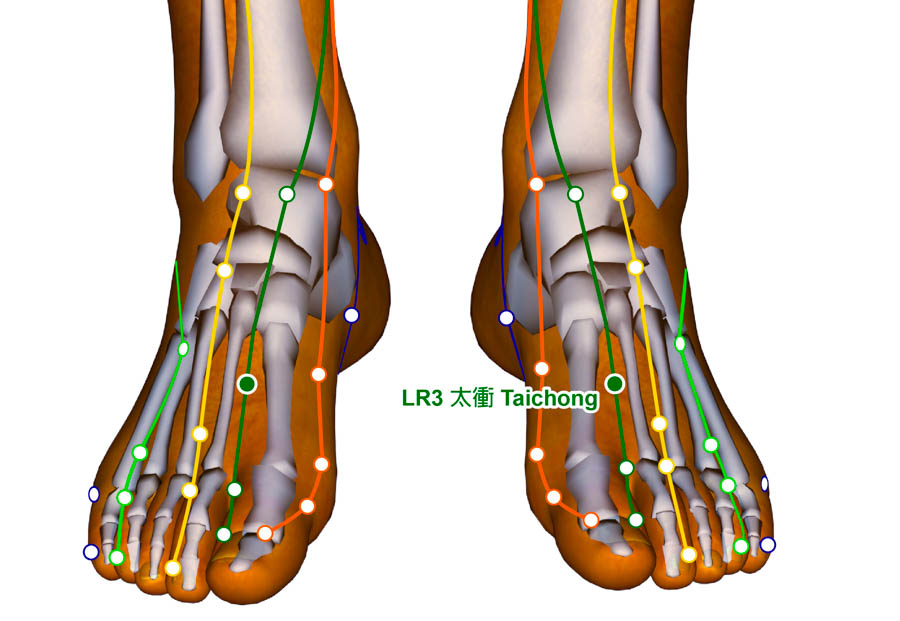
Acupuncture is an effective treatment for shoulder periarthritis, a disorder characterized by pain and limited range of motion. Shanxi University of Traditional Chinese Medicine researchers conducted a clinical trial on the efficacy of treating acute periarthritis with acupuncture at Yanglingquan (GB34) and Taichong (LV3) acupoints combined with local exercises. This approach utilized the special opposite side of affliction needling techniques, which facilitates shoulder movements during attenuation manipulation methods. The research team compared this approach with a standard acupuncture procedure. The results show that the intergral approach of acupuncture plus special exercises yields superior patients outcomes. [1]
The study used the following design. A total of 60 patients admitted to the hospital were randomly divided into an integral treatment group receiving acupuncture on Yanglingquan and Taichong acupoints combined with local exercise and a standard acupuncture control group, with 30 cases in each group. In the control group, age range was 49 to 70 years. Mean age was 61.23 ±6.442 years. Course of condition was five to 30 days. Average course of condition was 16.40 ±6.563. Fourteen were males and sixteen were females. In the integral group, age range was 47 to 71 years. Mean age was 57.57 ±7.798 years. Course of the preexisting condition was five to 30 days. Average course of condition was 18.43 ±6.719 . Seventeen were males and thirteen were females. Statistical baselines were the same in both groups prior to beginning treatments. Patients with severe diseases of the vital organs and mental disorders were excluded from the study.
The measurement parameters in the study involved VAS scores for degree of pain and Melle scores for range of shoulder motion. As for VAS score, that of the control group decreased from 6.27 ±1.230 to 3.867 ±0.973, while the integral group presented a more significant decline from 6.37 ±1.273 to 2.033 ±0.809 after completion of the treatments. Regarding Melle score, a more marked decrease was seen in the integral group (10.50 ±3.749 to 3.933 ±1.982) compared with the control group (10.73 ±3.600 to 7.067 ±3.321).
Patients in both groups received treatment for one week. For the integral group, patients were instructed to take a supine position while an acupuncturist performed the therapy. Needles (0.30 ×40 mm) were sterilized and inserted into Yanglingquan and Taichong on the unaffected side of the body. While receiving acupuncture, patients needed to do exercises, including bending, stretching, abduction, lifting, and rotation. Needle retention time was 30 minutes. An attenuating manipulation technique was applied every ten minutes. Insertion depth was 25 to 40 mm. A TDP heat lamp device was used to provide infrared heat radiation for the local area.
For the standard acupuncture control group, patients were instructed to take a lateral position. Needles of the same size as in the integral group were inserted perpendicularly. A mild reinforcing-attenuating method was applied. Needle retention time was 30 minutes. A TDP device was used as well. The following points at the affected side were used:
- Ashi (Extra)
- LI10 (Shousanli)
- TB14 (Jianliao)
- SI9 (Jianzhen)
- TB5 (Waiguan)
The researchers note that shoulder periarthritis is closely associated with the leg jueyin channel (liver channel). By applying acupuncture stimulation to Yanglingquan and Taichong, the qi around the shoulder is effectively channeled and activated, hence providing relief not only to periarthritis, but also offering overall benefits to the liver channel. Another advantage to the integrated treatment protocol is that it uses fewer acupoints, thus it is more accessible to patients with qi deficiency and improves compliance with treatment procedures.
Yanglingquan (GB34), located on the gallbladder shaoyang channel, is the he-sea and earth point of the shaoyang channel and the meeting point of the sinews. As a result, GB34 is often used to benefit tendons, sinew, and joints of the entire body. GB34 is also a heavenly star point. HealthCMi authors note that GB34 is commonly used for lower extremity pain, stiffness, and contraction along with neck and shoulder disorders as well. The researchers indicate that the liver channel is related to shoulder periarthritis, which makes the externally-internally related gallbladder and liver channels a relevant choice for acupoints.
LV3 is another relevant choice for jueyin channel and organ dysfunction. Both dry tendon disorder (liver blood not nourishing and lubricating tendons) and qi stagnation are both relevant to shoulder periarthritis. LV3 is a shu-stream, source, and earth point of the channel. Like GB34, it is a heavenly star point. LV3 is perhaps one of the most accepted acupoints for the treatment of qi stagnation. It benefits the head, eyes, menstruation, nourishes liver blood and yin, spreads qi, and regulates the lower burner (jiao).
GB34 and LV3 together, needled on the opposite side of the affected shoulder, allowed the researchers to have patients engage in local exercises on the affected shoulder during treatment. The research shows that this approach yielded significant positive patient outcomes.
Reference:
[1] Zhang Huihuan, Li Yajie, Tian Peizhou, Lv Yue, Clinical observation on the treatment of acute periarthritis of shoulder by needling Yanglingquan and Taichong acupoints, Journal of Shanxi University of Traditional Chinese Medicine, 2022, Volume. 23 No. 5.


